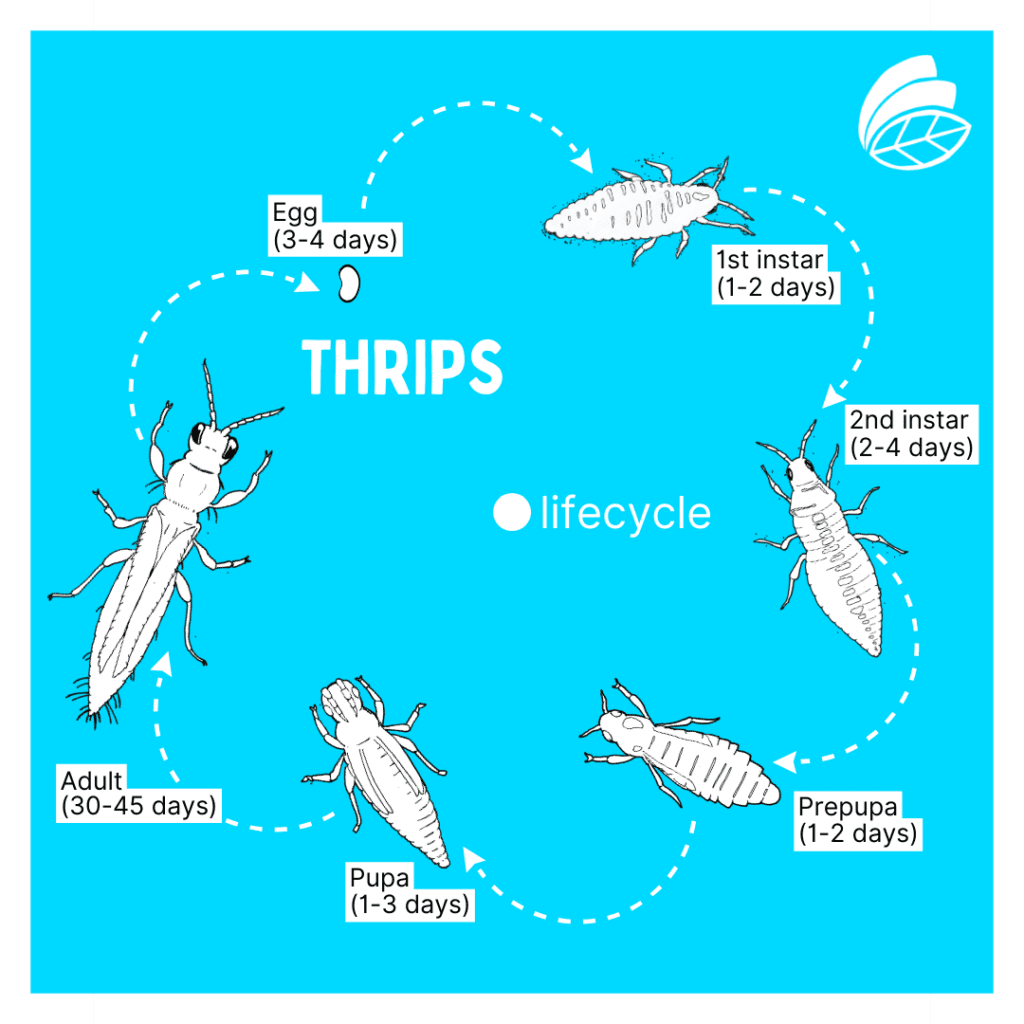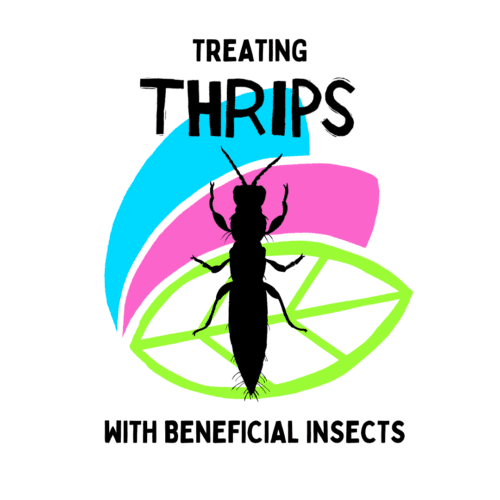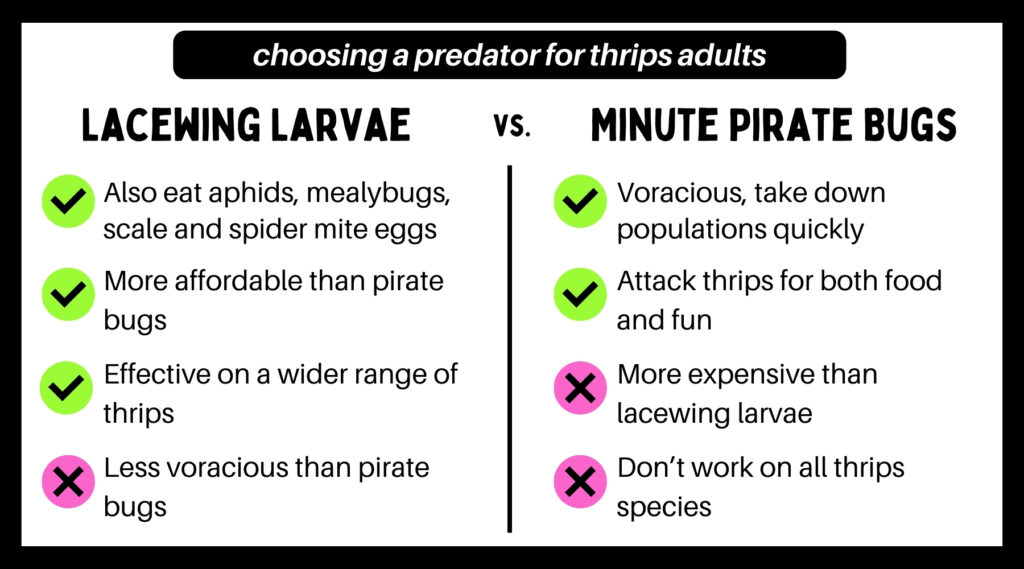
All About Thrips
Thrips, an insect in the family Thysanoptera, are tiny, slender insects with fringed wings that feed on the plant by piercing the outer layer of the leaf and sucking the contents out. They can be particularly destructive and move between plants with ease—while they cannot fly, they can leap about two feet.
There are thousands of species of thrips, some of which are actually beneficial and predatory! The ones that cause damage in our house plants tend to belong to the family Thripidae, of which there are around 300 species.
Fun fact: the singular of thrips is thrips!
The Thrips Lifecycle

Understanding the thrips life cycle is essential to treating them successfully.
Thrips adults lay eggs within the leaf tissue of the plant. As the eggs hatch, larvae emerge and eat their way out of the leaf (causing distinctive damage marks). The larvae feed on the plant for about five days*.
For many thrips species, once the larva matures through two more life stages, it will drop down into the growing medium to pupate. The pupal stage takes about three days*, and then the thrips will emerge from the growing medium as the long, black, winged adult where the cycle starts again. The adults move quickly and jump when approached, almost like fleas.
A full thrips life cycle can take anywhere from just a few days to up to 45 days* to complete.
*Lengths of time presented in this summary are averages and will vary depending on environmental conditions.
What Thrips Look Like
Thrips adults are fairly distinctive: sleek and slender black or brown insects that look somewhat like a pencil shaving. They tend to stand out from the leaf surface.
Thrips larvae are much smaller than the adults and tend to be a clear, yellowish color. They are often sedentary and resemble specks of dust. To distinguish them from dust, try poking them to see if they move; if it’s a thrips larvae, it will wriggle like a worm or begin to crawl away. Larvae often hide in the crevices of a plant, or along the leaf veins.
Inspecting for Thrips
Thrips are excellent at hiding. By the time you are seeing the adults, you have a lot of thrips. You’re more likely to notice the damage caused by thrips (see below) before you see the insects themselves.
When inspecting your plant for thrips, be sure to pull back where the leaves meet the stem or any leaf-like material attached to the base of the plant. They also often hide where the leaves meet, in divots in the leaves, or in papery debris (like old leaf sheaths). Peel and remove dead leaves as you inspect.
Examples of Thrips Damage
Thrips damage most often presents as:
- Coppery streaks or circles on the backs of older leaves.
- Indentations on the leaves.
- Yellowing and browning around the leaf edges.
- “Fish scale” type pattern of damage.
- New leaves that unfurl deformed or damaged, or struggle to unfurl altogether.
- Round holes or streaks in new growth.
- Tiny, raised dark brown or black spots on the leaves that wipe off; they may also appear wet. (This is thrips poop!)
Treating Thrips with Beneficial Insects
Treatment Overview
A comprehensive thrips treatment plan includes three types of predators to address every life stage of the thrips:
- For the teenagers and adults: Minute pirate bugs or lacewing larvae
- For the young larvae: Cucumeris mites (or swirskii mites for temperatures above 85°F)
- For the pupae in the soil: Stratiolaelaps mites or SF nematodes
Release fresh predators every two weeks for at least three consecutive treatments to ensure full eradication.
Choosing your predators
Choosing between lacewing larvae and minute pirate bugs:
The short answer is they are both good predators!
Pirate bugs tend to be somewhat more voracious because they attack thrips for fun and not just food (they actually carry the dead thrips bodies around as trophies which is somewhat satisfying). However, they are more expensive than lacewing larvae (about twice the cost), and they don’t work on all thrips species.
Lacewing larvae are also good thrips predators, with the added benefit that they also eat other soft bodied insects such as aphids, mealybugs, scale, and spider mite eggs. Lacewing larvae are effective against a wider variety of thrips species, so if you’re not sure which species you have, lacewings are a good choice over pirate bugs.
If your budget allows, we recommend choosing pirate bugs for at least the first application to treat aggressively, then switch to lacewings for the remaining applications. You can also use them both at the same time if you choose to.
Choosing between cucumeris and swirskii mites:
We recommend cucumeris mites in almost all situations. The only situation in which we recommend swirskii mites instead is for grow temperatures above 85 degrees. Do not combine them, as swirskii mites will predate on cucumeris mites.
For cucumeris mites: bulk release, sachets, or both?
There are two different methods of releasing cucumeris mites. The bulk release containers—also referred to as rapid release—contain a high percentage of adult cucumeris mites. The sachets—also referred to as slow release—are small self-contained bags that have been engineered to create the perfect microbiome in which the cucumeris mites can successfully reproduce several generations. These sachets contain a combination of adults, juveniles, and eggs. The cucumeris mites emerge on their own from the sachets.
It is best to use the bulk/rapid-release bags for plants with active pest issues. Sachets are ideal for prevention, but can be used to support the rapid release bag for taller plants. If your budget allows, you can use both bulk release and sachets for your initial release.
Choosing between stratiolaelaps and nematodes as a soil predator:
Stratiolaelaps are more voracious and should be used for your first two applications. After that, you can switch to one application of nematodes for longer term prevention.
Nematodes can also be a cost-saving option for larger collections (50+ plants). They live longer in your soil but are not as voracious as Stratiolaelaps.
For plants growing in semi-hydro, nematodes are not an option. For plants in semi-hydro, you can continue to use Stratiolaelaps after your second release for longer term prevention.
Other things to consider when budgeting for predators:
- Bulk cucumeris mites are cheaper than the sachets, and 1 liter goes much farther than the equivalent cost for 20 sachets.
- Stratiolaelaps should live up to eight weeks in ideal conditions, so you could skip them on the second release to reduce cost.
- For large collections (50+ plants in soil substrates), nematodes can be a cost-saving option over Stratiolaelaps, as they will live up to 6 months or longer in your soil.
- For large collections, consider getting less expensive lacewing eggs instead of live larvae.
- You can use pirate bugs and lacewing larvae together; depending on your specific thrips situation and collection size, it can sometimes reduce cost to use a partial bottle of pirate bugs for the most affected plants and lacewing larvae on nearby plants.
Before Releasing Predators
Scout for and manually remove any thrips adults or larvae you find, either with a strong jet of water or a wet washcloth. Don’t worry, you’re not removing the predators’ food—there will be plenty of thrips you won’t find yourself—rather, you’re working with the predators to knock out the pests.
If you opt to remove with a jet of water, make sure to spray your plant at an angle that avoids the growing medium. You want to wash your thrips down the drain, not into your growing medium where they can just crawl back up onto your plant. We generally recommend the wet washcloth method for this reason. Using the towel, wipe any adults or larvae you find and smush them in the towel.
Release Process and Timeline
If you’re new to beneficial insects or are using a new type of predator, visit our Release Tutorials for step-by-step guides.
The gold standard for thrips treatment is to release all three predators, fresh, every two weeks for three consecutive treatments. After that, if you’re not seeing any adults or larvae, you can begin the “step down approach,” in which you incrementally extend the amount of time between releases.
The “Step Down Approach”:
- For your third release, you do fresh lacewing larvae, cucumeris sachets, and nematodes.
- Wait up to four weeks.
- At four weeks, if you still have not seen larvae or damage on new growth, release fresh lacewing larvae and cucumeris sachets.
- Wait six weeks.
- At six weeks, if you are still not seeing larvae or damage on new growth, apply fresh lacewing larvae and cucumeris sachets again.
The step down approach is important because of thrips’ long life cycle and potential dormancy periods. Thrips can lie dormant for up to 60 days depending on environmental conditions, Stopping treatment cold turkey can lead to a resurgence of thrips in just a few weeks.
Common Mistakes When Treating Thrips
- Not sticking to the every-two-weeks release schedule, particularly for the first two releases.
- Not scouting and manually removing thrips while treating.
- Not checking nearby plants when you find evidence of thrips on a plant.
- Speaking the words, “I think they’re finally gone.”
Common Questions About Using Beneficial Insects to Treat Thrips
Once I start releasing beneficials, when can I expect to stop seeing thrips?
If you release all three predators as recommended, on average you should stop seeing adult thrips and larvae around day 9-16.
Do I need to use bulk cucumeris for an active issue, or can I use only sachets?
Bulk release cucumeris is the more cost-effective way to treat an active thrips issue. You can treat them using only sachets, but you will need to ensure you have multiple sachets per plant.








